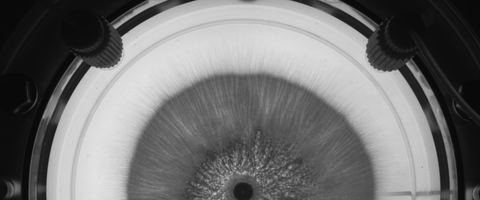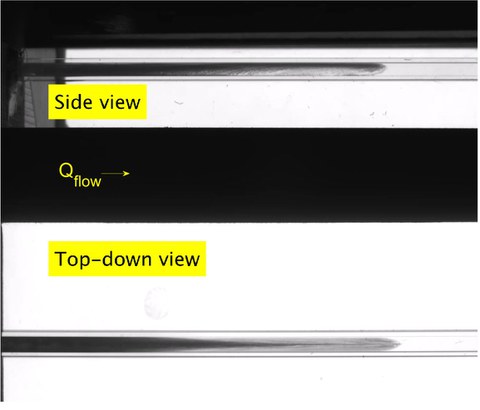Chemo-Hydrodynamik an partikelbildenden Reaktionsfronten
Kontaktperson: Dr.-Ing. Karin Schwarzenberger
Projektbearbeiter: Dipl.-Ing. Patrick Schlereth
Finanzierung: Deutsches Zentrum für Luft- und Raumfahrt (DLR) mit Mitteln des Bundesministeriums für Wirtschaft und Energie (BMWi) aufgrund eines Beschlusses des Deutschen Bundestages (Förderkennzeichen 50WM2443, Projekt ChemFront)
Motivation
Reaktions-Diffusions-Advektions (RDA) Fronten sind Phänomene, die in einer Vielzahl von Disziplinen auftreten und ein faszinierendes Zusammenspiel chemischer und physikalischer Mechanismen darstellen. Obwohl sie für Anwendungen der Nanotechnologien, CO₂-Sequestrierung und der Restaurierung von Kunstwerken relevant sind, sind die Dynamiken solcher Systeme noch nicht vollständig verstanden. Um die Einflüsse von Auftriebskräften weiter zu erforschen, werden Experimente im Mikromaßstab sowohl unter Standardgravitationsbedingungen (im Labor) als auch auf verschiedenen experimentellen Mikrogravitationsplattformen, z. B. an Bord eines Parabelfluges, durchgeführt.

Fällungsmuster einer RDA Front eines Laborversuches in einer Hele-Shaw Zelle
Ziele
- Untersuchung von Strömungsmustern und Instabilitäten in Reaktions-Diffusions-Advektions-Fronten
- Vergleich der Ergebnisse mit bestehenden Theorien und Vorschläge für neue Modelle
- Übertragung der Erkenntnisse auf industrielle Anwendungen (CO₂-Sequestrierung, Restaurierung von Kunstwerken, Rekalzifizierung)
Methoden
- Experimente in speziell angefertigten mikroskaligen Versuchsgeräten (wie Hele-Shaw-Zellen und ultradünne Kapillaren)
- Strömungsvisualisierungstechniken (z. B. μ-PIV, Stereo-PIV)
- Nutzung von Mikrogravitationsplattformen (Höhenforschungsraketenmission, Parabelflug)

RDA Front in einer dünnen Kapillare mit quadratischem Querschnitt in Seiten- und Draufsicht
Ergebnisse
Experimente werden in spezialisierten Aufbauten durchgeführt, die optischen Zugang bieten, um verschiedene Informationen über die laufende RDA-Reaktion zu extrahieren. Hele-Shaw-Reaktoren ermöglichen Einblicke in die radiale Frontausbreitung und die Musterbildung einer Fällungsreaktion. Ultrafeine Kapillaren erlauben die Beobachtung von Auftriebseffekten wie die Stratifikation der Reaktanten und die daraus resultierende Frontdeformation in sowohl Draufsicht als auch Seitenansicht.
Da RDA-Systeme durch das komplexe Zusammenspiel von Strömungseigenschaften und Produktbildung beeinflusst werden, wurde eine Charakterisierung der Fällungsreaktion
Na2CO3+CaCl2 → 2NaCl+CaCO3↓
in Advektions-, Agglomerations- und Gelbildungsregime vollzogen.
Erste Ergebnisse von Experimenten im Parabelflug deuten auf eine starke Abhängigkeit der RDA-Frontdynamik von Auftriebseffekten hin.
Publikationen
Stergiou, Y., Escala, D. M., Papp, P., Horváth, D., Hauser, M. J., Brau, F., ... & Schwarzenberger, K. (2024). Unraveling dispersion and buoyancy dynamics around radial A+ B→ C reaction fronts: microgravity experiments and numerical simulations. npj Microgravity, 10(1), 53.
Stergiou, Y., Perrakis, A., De Wit, A., & Schwarzenberger, K. (2025). Flow-driven pattern formation during coacervation of xanthan gum with a cationic surfactant. Physical Chemistry Chemical Physics.
